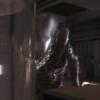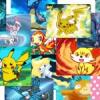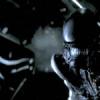H. R. Giger passed away on Monday. He was 74 years old.
Giger’s surrealist art was enormously influential across all mediums of science-fiction horror. The signature theme running throughout his works is an obsession with all things biomechanical—a macabre blending of human physiology and hard steel. “I’m an industrial designer,” Giger said of his influences. “I learned that, and furniture also, so I’m fascinated about vertebraes, about bones…”
More often than not, Giger’s art purposefully rubs up against social taboos. His work includes an undeniable element of sexuality, one that appears both perverse and sinisterly compelling. Small wonder, then, that Giger was chosen to create the alien/human seductress Sil for the 1995 film Species.
At first glance, it is hard to see how Giger’s work affected video games. The Swiss artist was most widely known for his design of the titular creature in Ridley Scott’s 1979 film Alien. He only ever provided art direction for one video game series— Amiga’s 1992 point-and-click Dark Seed, which got a sequel in 1995.
 But take a closer look at the heroes and villains in some of gaming’s top-billed entries, and Giger’s influence becomes readily apparent. The headcrab zombies of the Half Life series evoke Giger’s fixation with body-horror and are eerily reminiscent of Alien‘s face-huggers, which he designed. Shodan’s wire-and-tube scoured visage in System Shock 2 perfectly captures his image of man and machine blended seamlessly, and the legions of corrupted aliens in Mass Effect 3 draw obvious inspiration from his art. The necromorphs of the Dead Space series (which can only be defeated through tactical dismemberment, and have an altogether sexual vibe), feel lifted straight from one of Giger’s art pieces.
But take a closer look at the heroes and villains in some of gaming’s top-billed entries, and Giger’s influence becomes readily apparent. The headcrab zombies of the Half Life series evoke Giger’s fixation with body-horror and are eerily reminiscent of Alien‘s face-huggers, which he designed. Shodan’s wire-and-tube scoured visage in System Shock 2 perfectly captures his image of man and machine blended seamlessly, and the legions of corrupted aliens in Mass Effect 3 draw obvious inspiration from his art. The necromorphs of the Dead Space series (which can only be defeated through tactical dismemberment, and have an altogether sexual vibe), feel lifted straight from one of Giger’s art pieces.
Hans Rudolf Giger was born in Chur, Switzerland in 1940. Because his father was not entirely supportive of his aspiration to become an artist, he studied Architecture and Industrial Design at the School of Applied Arts in Zurich during the 1960’s.
His first widely-recognized body of work came in the form of his 1977 art-book Necronomicon, which took obvious inspiration from the writings of H.P. Lovecraft. It was this  collection of images that would bring Giger’s work into the international spotlight.
collection of images that would bring Giger’s work into the international spotlight.
Giger’s art was not without controversy. When one of his more explicit paintings was featured as an in-album poster for the Dead Kennedy’s Frankenchrist in 1983, the artwork became the subject of an obscenity trial.
In his personal life, H.R. Giger was well known for being something of a recluse. He typically only worked at night, and kept his shades drawn during the day.
It’s ironic, therefore, that many of the games that bear Giger’s influence feature an undeniable undercurrent of despair and longing. In Valve’s Half Life 2, we’re cast into a city under the bootheels of an interdimensional race of half-machine, half-organic monsters who have stripped humanity of it’s most basic function—the right to breed. One of the greatest “triumphs” the player achieves through fighting up from the dank sewers below is restoring humanity’s ability to reproduce. Giger would surely approve. Bioshock, with it’s horrifying Big Daddies and perversion of innocence, also feels instantly in tune with Giger’s visions.
 Likewise, Creative Assembly’s new Alien: Isolation (which draws almost entirely from Giger’s original art for the Alien film) casts the player as Amanda Ripley, a daughter searching for any sign of her mother, who went missing 15 years ago aboard a ship called the Nostromo. In the game, the player is forced to hide from a singular alien creature as it hunts them through the devastated Sevastapol station, cold and alone in the depths of space.
Likewise, Creative Assembly’s new Alien: Isolation (which draws almost entirely from Giger’s original art for the Alien film) casts the player as Amanda Ripley, a daughter searching for any sign of her mother, who went missing 15 years ago aboard a ship called the Nostromo. In the game, the player is forced to hide from a singular alien creature as it hunts them through the devastated Sevastapol station, cold and alone in the depths of space.
In fact, once you start looking for them, games affected by Giger’s work - whether deliberate or not - start revealing themselves in droves, and it’s more likely than not that his influence will continue well beyond his sad passing.
More often than not, H.R. Giger’s various works have provided inspiration for gaming’s villains, rather than its heroes. Obviously, his unique eye for finding the seams between vertebrae and steel, sexuality and death, evokes something primordially disturbing, yet also evocative in all of us. Whether his visionary creations are ultimately the villains or the heroes remains up to the player to decide.
What can’t be argued is the fundamental impact he had on science fiction and horror in videogames.
He will be missed, but certainly not forgotten.








